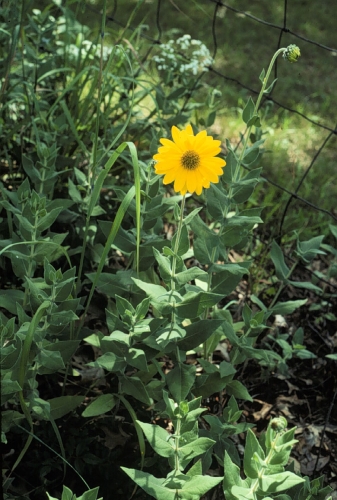Plants and Animals
Helianthus mollis Downy sunflower
Key Characteristics
Medium-sized forb (1 m) of prairies; leaves opposite, sessile and heart-shaped, covered with soft white hairs; flower yellow, relatively large (disc 2-3 cm wide, rays 2-3 cm long).
Status and Rank
US Status: No Status/Not Listed
State Status: T - Threatened (legally protected)
Global Rank: G4G5 - Rank is uncertain, ranging from apparently secure to secure
State Rank: S2 - Imperiled
Occurrences
| County | Number of Occurrences | Year Last Observed |
|---|---|---|
| Berrien | 1 | 1939 |
| Calhoun | 1 | 2010 |
| Cass | 1 | 1986 |
| Jackson | 1 | 1980 |
| Kalamazoo | 1 | 2006 |
| Monroe | 1 | 1985 |
| Muskegon | 1 | 2011 |
| Ontonagon | 1 | 1986 |
| St. Clair | 1 | 2011 |
| St. Joseph | 2 | 2009 |
Information is summarized from MNFI's database of rare species and community occurrences. Data may not reflect true distribution since much of the state has not been thoroughly surveyed.
Habitat
Found in prairie remnants in open sandy ground, and in dry, sandy disturbed areas along railroads, as well as in savannas.
Natural Community Types
For each species, lists of natural communities were derived from review of the nearly 6,500 element occurrences in the MNFI database, in addition to herbarium label data for some taxa. In most cases, at least one specimen record exists for each listed natural community. For certain taxa, especially poorly collected or extirpated species of prairie and savanna habitats, natural community lists were derived from inferences from collection sites and habitat preferences in immediately adjacent states (particularly Indiana and Illinois). Natural communities are not listed for those species documented only from altered or ruderal habitats in Michigan, especially for taxa that occur in a variety of habitats outside of the state.
Natural communities are not listed in order of frequency of occurrence, but are rather derived from the full set of natural communities, organized by Ecological Group. In many cases, the general habitat descriptions should provide greater clarity and direction to the surveyor. In future versions of the Rare Species Explorer, we hope to incorporate natural community fidelity ranks for each taxon.
Associated Plants
Little bluestem, big bluestem, colic root, wild indigo, common horsetail, path rush, hairy pinweed, pale spiked lobelia, mountain mint, meadowsweet, dewberry, butterfly weed, switch grass, leadplant, rosinweed, and prairie dock.
Management Recommendations
Protect habitat and hydrological and natural disturbance regimes. This species likely requires natural disturbances associated with prairie habitat such as prescribed fire or brush removal to prevent woody plant succession. Much of this habitat type has been lost or severely degraded.
Survey Methods
Random meander search covers areas that appear likely to have rare taxa, based on habitat and the judgment of the investigator.
References
Survey References
- Elzinga, C.L., D.W. Salzer, and J.W. Willoughby. 1998. Measuring and Monitoring Plant Populations. The Nature Conservancy and Bureau of Land Management, Denver. BLM Technical Reference 1730-1. 477pp.
- Goff, G.F., G.A. Dawson, and J.J. Rochow. 1982. Site examination for Threatened and Endangered plant species. Environmental Management 6(4): 307-316
- Nelson, J.R. 1984. Rare Plant Field Survey Guidelines. In: J.P. Smith and R. York. Inventory of rare and endangered vascular plants of California. 3rd Ed. California Native Plant Society, Berkeley. 174pp.
- Nelson, J.R. 1986. Rare Plant Surveys: Techniques For Impact Assessment. Natural Areas Journal 5(3):18-30.
- Nelson, J.R. 1987. Rare Plant Surveys: Techniques for Impact Assessment. In: Conservation and management of rare and endangered plants. Ed. T.S. Elias. California Native Plant Society, Sacramento. 8pp.
Technical References
- Antonio, T.M. and S. Masi. 2001.The Sunflower Family in the Upper Midwest. A Photographic Guide to the Asteraceae in Illinois, Indianan, Iowa, Michigan, Minnesota and Wisconsin. Indiana Academy of Science, Indianapolis. 421pp.
- Deam, C. C. 1940. Flora of Indiana. Department of Conservation, Indianapolis. 1236pp.
- Fisher, T.R. 1988. The Dicotyledoneae of Ohio. Part 3. Asteraceae. Ohio State University Press, Columbus. 280pp.
- Flora of North America Editorial Committee. 2006. Flora of North America, North of Mexico. Volume 21: Magnoliophyta: Asteridae (in part): Asteraceae, part 3. Oxford University Press, New York. 616pp.
- Gleason, H. A., and A. Cronquist. 1991. Manual of Vascular Plants of Northeastern United States and Adjacent Canada. 2nd Ed. The New York Botanical Garden, New York, New York.
- Gray, A. 1950. Gray's Manual of Botany; eighth ed. Van Nostrand Reinghold, New York. 1632pp.
- Holmgren, N.H. 1998. Illustrated Companion to Gleason and Cronquist's Manual. Illustrations of the vascular plants of Northeastern United States and adjacent Canada. New York Botanical Garden, Bronx. 937pp.
- Mohlenbrock, R.H. 1986. Guide to the Vascular Flora of Illinois. Southern Illinois University Press, Carbondale. 507pp.
- Swink, F. and G. Wilhelm. 1994. Plants of the Chicago Region, 4th ed. Indiana Academy of Science, Indianapolis. 921pp.
- Voss, E.G. 1996. Michigan Flora. Part III. Dicots (Pyrolaceae-Compositae). Bulletin of the Cranbrook Institute of Science and University of Michigan Herbarium. 622pp.


